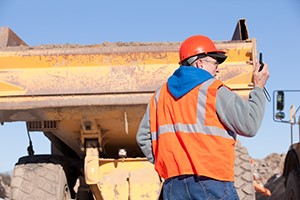How to Prevent Backover Accidents in Construction

Among the most common hazards of any worksite with moving vehicles or equipment is the backover incident, when a backing vehicle strikes someone in its path. Backing up large machinery is a difficult task for any driver, even more so when factoring in multiple vehicles, limited space, and numerous people on foot. But the right safeguards, including proper planning, training, and safety equipment, can prevent backover incidents.
How Do Backovers Happen?
Backovers are a critical hazard in many occupations. The Occupational Safety and Health Administration (OSHA) reports that the highest incident and fatality numbers are found in construction, trucking, highway work zones, and garbage collection, in which vehicle size and complexity, multiple vehicles operating in a limited space, and a crowded workflow with many on-foot workers near moving vehicles are common.
Accidents are also caused by:
- Distracted or negligent driving
- Poor visibility, especially blind spots prevalent with large vehicles or equipment
- Cluttered working areas
- Malfunctioning backup alarms
- High noise levels
- Distracted on-foot workers
- Workers slipping or falling, including falling off vehicles
Preventing Backover Incidents
OSHA has many recommendations for preventing backovers, which can include:
- Cameras: Rear cameras and dash-mounted camera displays for backing up are standard in many vehicles, and can also be installed to prevent front and side blind spots. Larger vehicles like dump trucks may require multiple cameras to account for all potential blind spots.
- Detection Systems: Proximity detection systems, including radar and ultrasonic technology like sonar, bounce signals off objects which return to a receiver and alert the driver to their presence and location.
- Electomagnetic Field-Based Systems: These systems use electronic sensing devices called tags that detect electromagnetic field generators. The tags can be programmed with a danger zone, a predefined distance between tag and generator, variety of safeguards, including alerting workers and even forcing a vehicle stop.
- Internal Traffic Control Plans: Safety begins with a good plan. An internal traffic control plan (ITCP) helps to manage the flow of workers, vehicles, and equipment at a site to spot and reduce hazards before work begins.
Spotters
One of the most common methods of protecting on-foot workers and ensuring safe vehicle operation is a spotter, a worker trained to recognize hazards and improper working practices, as well as guide vehicles using hand signals or other communication systems. The focus required to guide a vehicle can distract from other hazards, but good practices keep spotters safe, including agreed-upon hand signals that drivers are familiar with, constant visual contact between driver and spotter, vehicle stoppage if the spotter can’t be seen, and high-visibility safety clothing.
Backover Training
Proper training for employees can make all the difference on a busy worksite. Drivers and equipment operators should have necessary experience and certifications, in addition to training that emphasizes safety near vehicles as well. A spotter should have a dedicated role and be fully trained in its best practices. Employees who work on foot near vehicles should, like drivers, must understand those vehicles’ blind spots, so they’re aware of when a worker might be difficult to see from the driver’s seat. Finally, it’s easy for standards to slip and bad habits to reemerge over time, so regular toolbox talks can be used to remind crews of safe practices and reinforce existing skills.



